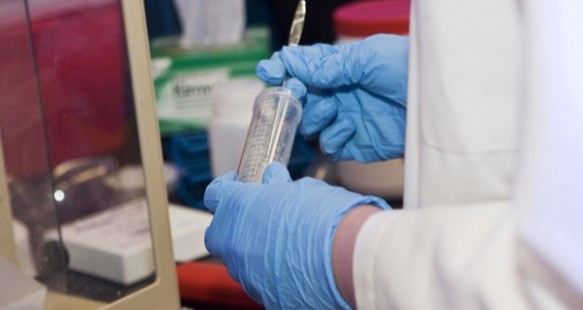
A new report analyzing U.S. research strengths underscores the contributions that Delaware’s higher education institutions make in generating new ideas and discoveries critical to long-term economic growth.
The report, America’s Knowledge Economy: A State-by-State Review, issued by the Council of State Governments and the academic publisher Elsevier, assesses research output and impact from 2004 to 2013. The scholarly research publications produced in each state are a key barometer for innovation.
Delaware had the second highest rate of peer-reviewed publication production nationwide. Delaware researchers produced 11.4 publications per million dollars in research and development (R&D) funding spent.
Delaware’s performance was nearly twice the national average and was exceeded only by Massachusetts, whose researchers produced 12.7 publications per million dollars in R&D expenditures.
Delaware generated 3.24 research publications per 1,000 residents in 2013, ranking the state sixth, ahead of New York, Pennsylvania, Colorado and Minnesota, among the top ten nationally.
“The state of Delaware cannot be successful without a successful research university, and the University of Delaware cannot succeed without a healthy and successful state,” said UD Provost Domenico Grasso. “This study points out how our collaboration contributes to a vital landscape of active economic development that benefits everyone.”
In fiscal year 2013, the total economic impact of the UD community and companies assisted by the University was $6.2 billion.
“These findings are a testament to the excellence and impact of University of Delaware faculty members and to their strong collaborations with colleagues at other academic institutions, in industry and in government labs,” said Charlie Riordan, deputy provost for research and scholarship. “As highlighted in UD’s draft strategic plan, Delaware Will Shine, partnerships are essential for a strong research enterprise and to our contributions in solving real-world problems, both locally and globally.”
In an analysis of where states have a comparative advantage in research, the report ranks Delaware 10th among all states in terms of research impact in the agricultural and biological sciences. Delaware’s publications were cited 18 percent more than the U.S. average for these fields.
In 2014, three UD researchers who work in agricultural sciences, marine sciences, bioinformatics and computational biology — Pamela Green, Blake Meyers and Cathy Wu — were named Thomson Reuters “Highly Cited Researchers” for writing the greatest numbers of reports ranking among the top 1 percent most cited for their subject field.
“Knowledge is power,” said Wu, who is the Edward G. Jefferson Chair of Bioinformatics and Computational Biology at UD. “Scientific publication is the best way for us to disseminate information and share knowledge with the research and user communities. With scientific literature now readily available in digital forms, and increasingly in open access journals, such information and knowledge are also being captured in numerous web resources using cutting-edge text-mining technologies with far-reaching, cascading impact.”
The report also reveals that Delaware researchers’ publications were cited 52 percent more than the global average in the past decade.
Green pointed out that scientists rely on published research to build on each other’s work and to compare results and interpretations. She holds the Crawford H. Greenewalt Chair in the Department of Plant and Soil Sciences and also is a professor in the School of Marine Science and Policy.
“This allows the scientific enterprise to be self-checking and for old results to further enhance progress when considered in the context of new discoveries,” Green said. “For university faculty, it is also critical to our teaching mission that our students and postdocs learn to effectively convey their work to the scientific community through peer-reviewed publications.”
Meyers, the Edward F. and Elizabeth Goodman Rosenberg Professor of Plant and Soil Sciences and chair of the Department of Plant and Soil Sciences, can be found working on his research journal articles at home, at work, and in airplanes and airports as he travels to national and international meetings. He likes the challenge of making complex data understandable.
“Publications represent the successful end product of my research activities, a way to communicate the findings we have made, and our ideas and current thinking about subjects of interest to us,” Meyers said.
The new report also examines research output across other sectors, including corporations, government research labs, hospitals and nonprofit think tanks.
The corporate sector contributed 13.9 percent of Delaware’s total research output during the period. It was the second highest in the U.S., only behind New Jersey at 20.8 percent. Additionally, 10.6 percent of Delaware’s total research output was from its medical sector — the third highest rate among all states.
According to the report, in 2013, the United States published more than 536,000 peer-reviewed research publications.
The report’s analyses draw significantly from Elsevier’s Scopus proprietary abstract and citation database of peer-reviewed research literature. It includes 56 million documents published in more than 22,000 journals, book series and conference proceedings by some 5,000 publishers.
To read the full report, visit the website.